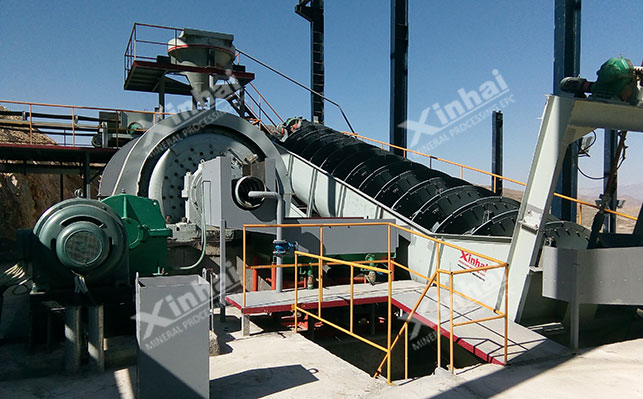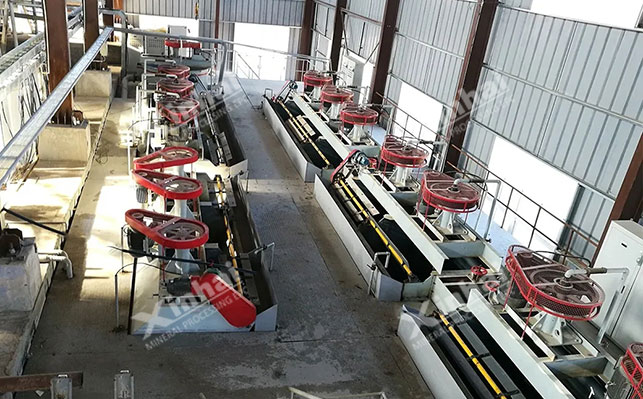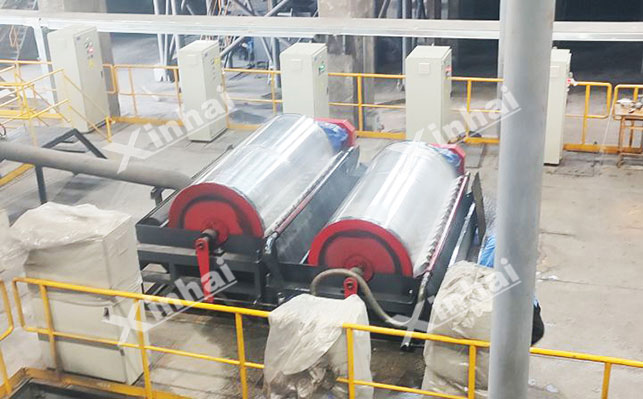
15311826613
Click to add WeChatFeldspar is a common non-metallic ore and an important raw material in the field of glass and ceramics. According to its different mineralization conditions, it can usually be divided into pegmatite-type high-quality ore, weathered granite ore, magmatic rock deposit, fine-grained rock ore, and feldspar sand ore. Feldspar beneficiation methods. Let's find out together!
This type of feldspar is a pegmatite-type high-quality ore. The crystallization degree of feldspar in its minerals is good, and the crystal particles are relatively coarse, which makes the feldspar crystal structure complete and the impurities are low. Therefore, the beneficiation process of this type of feldspar ore is relatively simple. The process is usually: hand selection-crushing-rod mill-classification, directly producing high-quality feldspar.

Hand selection: In the mined ore, obvious large impurities are manually selected, such as surrounding rocks, boulders of other non-feldspar minerals, etc. In this link, workers can quickly remove impurities with large appearance differences based on their experience, improve the overall quality of subsequent selected ores, and reduce subsequent equipment wear and processing burden.
Crushing: A two-stage open-circuit crushing process is adopted, in which a jaw crusher is used for coarse crushing, which can effectively crush large pieces of pegmatite ore to a certain size quickly; a hammer crusher is used for fine crushing, and the ore is impacted by a high-speed rotating hammer head to further reduce the particle size, so that the ore particle size meets the requirements of subsequent rod milling.
Rod milling: A wet rod mill is used to complete the grinding operation. This process can grind the crushed ore while protecting the feldspar crystal structure. Rod mills have less over-crushing phenomenon, can better maintain the characteristics of feldspar minerals, and provide products of suitable particle size for subsequent classification.
Classification: A vibrating screen or a high-frequency fine screen is used to screen according to the size of mineral particles. The feldspar products with qualified particle size are separated, and the coarse particles are returned to the rod mill for re-grinding, thereby directly producing high-quality feldspar.
Although the beneficiation process of pegmatite-type feldspar ore is simple, it is highly efficient, making full use of the characteristics of pegmatite-type high-quality ore itself and reducing the cost increase caused by complex beneficiation process.
In weathered granite-type feldspar ore, the feldspar is embedded in fine particles and often coexists closely with other minerals, which not only increases the difficulty of mineral dissociation. At the same time, it is often accompanied by a large amount of clay and other muddy impurities, which not only affect the physical properties of the ore, but also interfere with subsequent beneficiation operations. In addition, it may contain impurities such as iron minerals and quartz, making the ore properties relatively complex, and it is necessary to combine a variety of beneficiation methods for treatment. The commonly used processes are mainly: crushing-grinding-classification-flotation (iron and quartz removal).

Crushing: Similar to pegmatite-type high-quality ore, jaw crusher is used for coarse crushing and hammer crusher is used for fine crushing. However, since there may be more weathered parts in weathered granite ore, attention should be paid to the wear of the equipment and the uniformity of feeding during the crushing process to ensure the crushing effect and stable operation of the equipment.
Grinding: In order to fully dissociate feldspar from other minerals, the grinding fineness must be controlled at -0.074mm, accounting for more than 85%. A wet rod mill and a vibrating screen are used to form a closed-circuit system to ensure that the particle size of the grinding product meets the standard and is uniform, providing a good foundation for subsequent mineral processing operations.
Classification: Use a spiral classifier or a hydrocyclone to remove fine mud. If the ore contains clay minerals such as chlorite, add a scrubbing and desludging process to remove the interference of clay on subsequent flotation.
Flotation: This link is mainly used for iron removal and separation of quartz. For iron removal, a dry countercurrent permanent magnetic drum magnetic separator is used for strongly magnetic minerals (magnetite, mechanical iron); a high gradient magnetic separator is used for weakly magnetic minerals (hematite, biotite). When separating quartz, acid flotation can be used, using hydrofluoric acid to activate the surface of feldspar, and amine collectors to adsorb feldspar to separate it from quartz; or alkaline flotation can be used, sodium carbonate is adjusted, and sulfonate is used to collect quartz to achieve the purpose of removing quartz and purifying feldspar.
Feldspar minerals in magmatic rock deposits often coexist with nepheline, orthoclase, etc., and the mineral composition is relatively complex. Moreover, it may contain a certain amount of magnetic minerals, which makes beneficiation more difficult. The combined process of gravity separation and magnetic separation is often used. The process is as follows:

Crushing and grinding: First, crush by jaw crusher and hammer crusher, and then grind by wet rod mill, control the grinding fineness to meet the subsequent separation requirements, and make the minerals fully dissociated.
Combined gravity-magnetic separation process: In the gravity separation stage, for high-density impurity minerals with a density greater than 3.5g/cm³, such as rutile and garnet, a combination of spiral chute roughing and shaking table selection is used to initially separate nepheline and orthoclase by using the difference in mineral density. In the magnetic separation stage, a magnetic separator is used to further remove magnetic minerals based on the difference in mineral magnetism. Strong magnetic minerals are removed by a magnetic separator with a lower magnetic field strength, while weak magnetic minerals are treated by a high-gradient magnetic separator. Through the synergistic effect of gravity separation and magnetic separation, nepheline, orthoclase and other impurities are effectively separated to improve the purity of feldspar concentrate.
The mineral crystal size in fine-grained rock is fine, which makes the minerals closely interlocked. At the same time, it contains impurities such as mica and iron minerals. The presence of mica may affect the quality of feldspar concentrate, and iron minerals need to be removed by magnetic separation and other methods to improve the purity of feldspar products. Its process is usually crushing-grinding-screening-magnetic separation.

Crushing and grinding: After coarse crushing by jaw crusher and fine crushing by hammer crusher, the ore enters wet rod mill for grinding, and the ore is ground to a suitable particle size, so that mica, iron minerals and feldspar are fully dissociated, creating conditions for subsequent screening and magnetic separation.
Screening: Use vibrating screen to grade the particle size of the grinding products, remove oversized or undersized particles, ensure the uniform particle size of the minerals entering the magnetic separation link, and improve the efficiency of magnetic separation.
Magnetic separation: For strongly magnetic iron minerals (such as magnetite and mechanical iron), a dry countercurrent permanent magnetic drum magnetic separator (magnetic field strength 0.8-1.2T) is used; for weakly magnetic iron minerals (such as hematite, etc.), a high gradient magnetic separator (magnetic field 1.6-2.0T) is used to separate iron minerals from feldspar ores through magnetic separation, thereby improving the quality of feldspar products. If mica needs to be further recovered, flotation process can be used in magnetic separation tailings, such as recovering mica through a one-rough and two-fine scavenging process.
Feldspar sand ore is a ore with fine particle size and often contains a large amount of fine impurities such as clay, which are dispersed. Although the mineral composition is relatively simple, the dispersion of impurities increases the difficulty of mineral processing. It is necessary to use pretreatment methods such as water washing and desliming to improve the purity of the selected ore. Subsequently, according to the difference in the properties of impurities and feldspar, flotation or screening methods are selected for further treatment. The process is water washing and desliming-flotation/screening.
Water washing and desliming: Use water flow to wash and remove fine impurities such as clay in the sand ore. Special ore washing equipment, such as a cylindrical ore washer, can be used to separate clay from feldspar sand through mechanical stirring and water flow flushing, thereby improving the purity of the selected ore.
Flotation/screening: If the density or surface properties of impurity minerals and feldspar in feldspar sand ore are quite different, flotation process can be used. When it contains impurities with good floatability such as chlorite, feldspar and impurities can be separated by flotation machine under appropriate flotation reagent system. If the impurity problem is mainly caused by particle size difference, screening can be carried out directly. Different screen apertures can be selected according to product requirements to classify feldspar sands of different particle sizes, remove coarse or fine impurities that do not meet the requirements, and obtain qualified feldspar products.
The above mainly introduces the mineral processing flow of several different types of feldspar ores and the ore characteristics of each feldspar. In actual mineral processing plants, no matter what kind of feldspar, its ore properties are different. Therefore, each link of mineral processing must meet its own conditions to obtain ideal feldspar concentrate. It is recommended to conduct mineral processing tests and use the test data to tailor a suitable feldspar mineral processing plan for each mineral processing plant, which is the key to obtaining an ideal recovery rate.